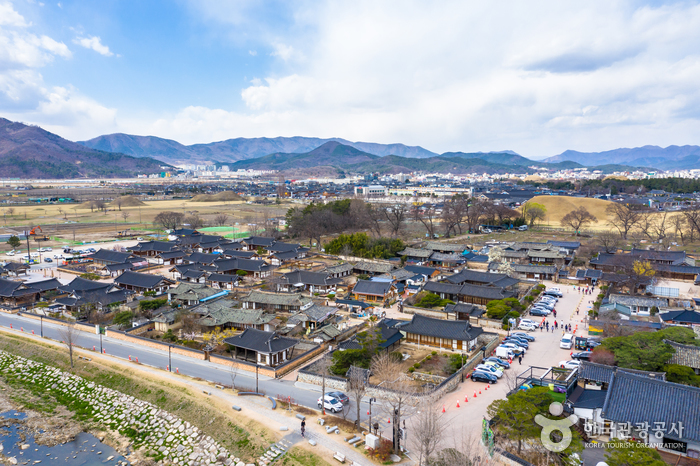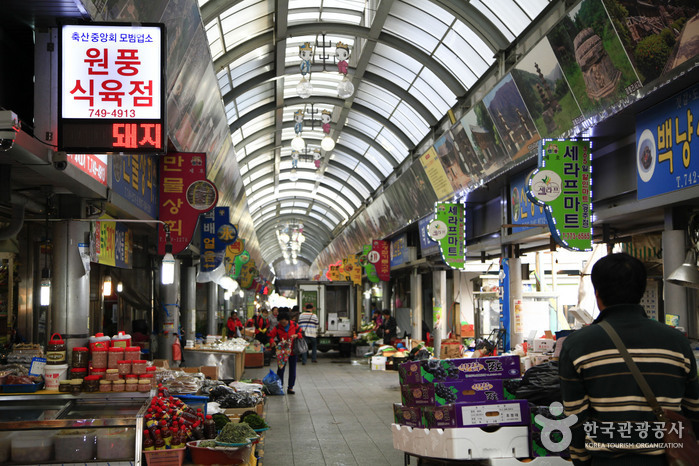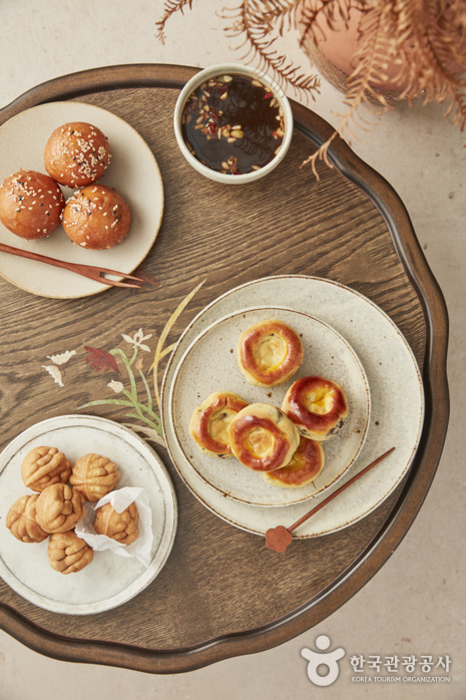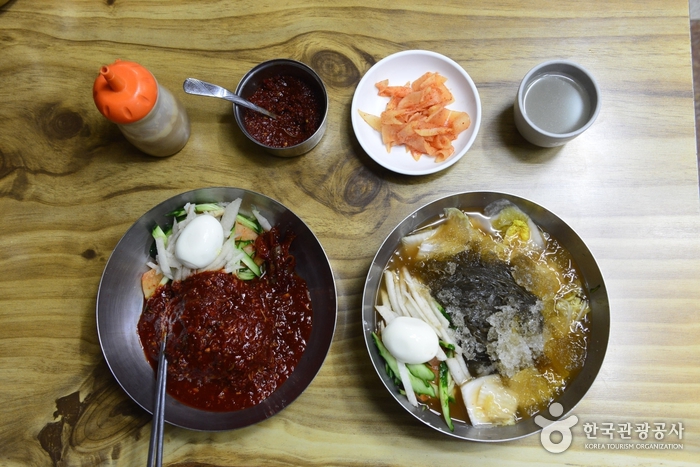SOSEOLJAE [Korea Quality] / 소설재(첨성대점) [한국관광 품질인증]
6.0Km 2021-04-01
46, Poseok-ro 1050beon-gil, Gyeongju-si, Gyeongsangbuk-do
+82-54-7357-7412
As a traditional Korean guesthouse with modern facilities but with some traditional features of a Korean house such as wooden floor and ceramic tiled roof intact, Soseoljae is located next to Cheomseongdae in Gyeongju. It also has an old well in the garden. Each guestroom is furnished with bathroom and air conditioner for the convenience of the guests. The single-story guesthouse has a total of 11 rooms that can accommodate 2-4 people depending on the size of the room. The two-story stand-alone guesthouse located right next to the main gate can accommodate six, and it has a small tea room. The guesthouse has a cafe at the entrance. It's conveniently located near Cheomseomdae, Daereungwon Ancient Tombs, and Hwangnyongsaji (Hwangnyongsa Temple Site) as well as Gyeongju Station and Gyeongju Express Bus Terminal.
Village Gyochon de Gyeongju (경주 교촌마을)
6.0Km 2025-06-10
39-2, Gyochon-gil, Gyeongju-si, Gyeongsangbuk-do
+82-54-760-7880
Le village Gyochon de Gyeongju est un village traditionnel constitué de hanok devenu site touristique proposant diverses activités pratiques pour les visiteurs. Le village abrite notamment la maison Gyeongju Choi Ssi, classée comme 27ème trésor du patrimoine folklorique en Corée ainsi qu'une fabrique de l'alcool Gyeongju Gyodong Beopju classé trésor immatériel num. 86-3.
ALLEY HOSTEL & GUESTHOUSE [Korea Quality] / 앨리게스트하우스 [한국관광 품질인증/Korea Quality]
6.1Km 2021-03-29
12, Gyerim-ro 106beon-gil, Gyeongju-si, Gyeongsangbuk-do
ALLEY, a guesthouse located in the center of Gyeongju , is located only 3 min by foot from Gyeongju Station. Its supreme accessibility makes it a popular accommodation for backpackers in Gyeongju. There are no parking lots on the promise, but guests renting family rooms have access to parking services.
The first floor of the guesthouse has a lobby, common kitchen, luggage storage, and laundromat. The kitchen offers self-service complimentary breakfast. Visitors can make their own toasts and fried eggs to have with coffee and beverages. The second and third floors house guest rooms. The rooms available include single-occupancy rooms, double-occupancy rooms with single beds, double-occupancy rooms with bunk beds, triple-occupancy rooms with bunk beds, 4-person family rooms with bunk beds, and 4-person dormitory rooms with bunk beds. The family room supports up to five guests. All rooms are equipped with air conditioning and door locks, and have restrooms with shower facilities. Amenities include towels, soap, shampoo, hair conditioner, toothpaste, and hair dryer. Guests also have access to the third floor’s open-air terrace, and may store their luggage there even before their check-in. Daereungwon Ancient Tomb Complex lies about 10 min from the guesthouse, while Cheomseongdae Observatory and Donggung Palace and Wolji Pond can be found 20 min away.
Marché Seongdong à Gyeongju (경주 성동시장)
6.1Km 2025-04-02
12, Dongmun-ro 24beon-gil, Gyeongju-si, Gyeongsangbuk-do
+82-54-772-4226
Hwangnam-bbang(황남빵)
6.1Km 2025-04-02
783, Taejong-ro, Gyeongju, Gyeongsangbuk-do, Corée du Sud
Hwangnam-bbang a été créé en 1939 à Hwangnamdong, Gyeongju, et le nom, qui était utilisé par les personnes venant acheter du pain pour désigner Hwangnam-bbang, a été conservé et est devenu le nom officiel. Le fondateur de Hwangnam-bbang, le regretté Choi Yeong-hwa, était un descendant de la famille Choi de Gyeongju et, à l'âge de vingt et un ans, il a créé ce produit après de nombreux efforts. En utilisant une méthode spéciale développée à partir de l'habitude familiale de fabriquer des gâteaux et des pains à base de haricots rouges, il continue de privilégier le goût des haricots rouges même après 80 ans. Hwangnam-bbang se distingue par son magnifique motif en forme de stries, qui évoque l'atmosphère de Silla.
Pyeongyang Naengmyeon (평양냉면)
6.2Km 2017-01-19
109-2, Wonhyo-ro, Gyeongju-si, Gyeongsangbuk-do
+82-54-772-2448
The restaurant of Pyeongyang Naengmyeon has been operated through two generations and thus is very famous in Gyeongju. Its noodles are hand-made from starch of Korea-grown buckwheat and potato and broth is made by deeply boiling beef bones. So, noodles are chewy and broth tastes rich and clean.
Zone historique de Gyeongju [Patrimoine mondial de l’UNESCO] (경주역사유적지구)
6.2Km 2025-03-27
757, Taejong-ro, Gyeongju-si, Gyeongsangbuk-do
+82-54-779-6100
La zone historique de Gyeongju, enregistrée au patrimoine culturel mondial de l’UNESCO en novembre 2000, personnifie l’histoire et la culture millénaires de Gyeongju, l’ancienne capitale du royaume de Silla (新羅, 57-935).
Cette zone peut être divisée en cinq grandes sections. La première, la zone de Namsan, renferme de véritables trésors de l’art bouddhiste qui datent de l’époque du royaume de Silla. Le Mont Namsan de Gyeongju, souvent décrit comme un musée à ciel ouvert, abrite de nombreux monuments historiques de la dynastie Silla, parmi lesquels Poseokjeong (site historique n° 1), Tapgok Maaejosanggun (trésor n° 201), la pagode de pierre de trois étages de Cheollyongsaji (trésor n° 1188), le Bouddha de pierre de Chilbulam Maae (trésor n° 200), la statue assise de Bouddha de Bulgok (Treasure No. 198), et 37 autres reliques du Bouddhisme.
La zone de Wolseong forme la seconde section, et marque l’emplacement d’un ancien palais du royaume de Silla. On y trouve Gyerim (site historique n°19), Imhaejeonji (site historique n° 18), qui est l’emplacement d’un palais royal de Silla, et le Cheomseongdae (trésor national n° 31), le plus vieil observatoire d’Asie. La troisième zone, celle de Daereungwon, accueille un groupement de tombes royales des rois et des reines de Silla. Non loin de là se trouvent entre autres un Gobungun (un ancien cimetière) à Nodong-ri (site historique n° 38), un autre Gobungun à Noseo-ri (site historique n° 39), un troisième Gobungun à Hwangnam-ri (site historique n° 40) et Oreung (site historique n° 172). Les archéologues ont découvert dans cette zone des reliques historiques inestimables, parmi lesquelle Geumgwan (une couronne d’or), Cheonmado (a une peinture de chevaux volants), et de nombreuses poteries. Ces trouvailles ont apporté de précieux renseignements sur la vie quotidienne du peuple vous la dynastie Silla.
La quatrième zone, celle de Hwangnyongsa, marque l’emplacement de l’ancien temple de Hwangnyongsa (site historique n° 246) et de la pagode de pierre de Bunhwangsa. Finalement, la zone de Sanseong abrite de nombreux vestiges des fortifications de la capitale. On y trouve la forteresse de Myeonghwalsanseong (site historique n°47), qu’on estime vieille de 400 ans environ.
La zone historique de Gyeongju possède au total 52 biens culturels désignés, enregistrés sur la liste du patrimoine culturel mondial.
[ Zone de Namsan(남산지구)(Site Historique) ]
- Bouddha sculpté dans la roche du temple de Borisa(보리사마애석불)(Bien culturel immatériel régional), Bouddha assis en pierre dans la vallée de Mireukgok du mont Namsan(미륵곡 석불좌상)(Trésor), Pagode en pierre à trois étages dans la vallée de Yongjangsa(용장사곡 삼층석탑)(Trésor)
- Bouddha assis sculpté dans la roche(석불좌상)(Trésor), Statue bouddhique en pierre du temple de Yonggansaji(용장사지 마애여래좌상)(Trésor), Pagode en pierre à trois étages de Cheonryongsaji(천룡사지 삼층석탑)(Trésor)
- Supports de mât de drapeau sur le site du temple de Namgansa(남간사지 당간지주)(Trésor), Puits en pierre du site de Namgansa(남간사지 석정)(Bien culturel immatériel régional), Pagode en pierre à trois étages de Namsan à Gyeongju(경주남산리 삼층석탑)(Trésor)
- Triade de Bouddhas debout en pierre de Bae-dong(경주배리 석불입상)(Trésor), Statue assise en pierre de Yuneulgok(윤을곡 마애불좌상)(Bien culturel immatériel régional), Trois tombes royales(삼릉)(Site Historique)
- Bouddha assis sculpté dans la vallée de Bulgok(불곡 석불좌상)(Trésor), Bodhisattva sculpté dans la roche au hermitage de Sinseonam(신선암 마애보살반가상)(Trésor), Bouddha sculpté dans la roche de Chilbulam(칠불암 마애석불)(Trésor)
- Groupe de statues en pierre de Tapgok(탑곡 마애조상군)(Trésor), Bouddha assis en pierre dans la vallée de Samneung du mont Namsan, Gyeongju(경주 남산 삼릉계 석조여래좌상)(Trésor)
- Statue de la bodhisattva Gwan-eum sculptée dans la roche dans la vallée de Samneung(삼릉계곡 마애관음보살상)(Bien culturel immatériel régional), Statue assise de Sakyamuni/Sage sculptée dans la roche dans la vallée de Samneung(삼릉계곡 마애 석가여래좌상/선각여래좌상)(Bien culturel immatériel régional)
- Six reliefs de Bouddha en linéaire dans la vallée de Samneung(삼릉계곡 선각 육존불)(Bien culturel immatériel régional), Tête de Bouddha en pierre d'Ipgok(입곡 석불두)(Bien culturel immatériel régional), Statue assise de Bouddha dans la vallée d'Erosion(침식곡 석불좌상)(Bien culturel immatériel régional)
- Statue assise en pierre de Yeolamgok(열암곡 석불좌상)(Bien culturel immatériel régional), Bouddha en relief dans la vallée de Yaksoo(약수계곡 마애입불상)(Bien culturel immatériel régional)
- Statue de Bouddha sculptée dans la roche au mont Baegun(백운대 마애석불입상)(Bien culturel immatériel régional), Site du pavillon de Poseokjeong(포석정지)(Site Historique), Forteresse de Namsan à Gyeongju(경주 남산성)(Site Historique), Étang de Seochulji(서출지)(Site Historique)
- Tombeau du roi Ilseong à Gyeongju(신라일성왕릉)(Site Historique), Tombeau du roi Jeonggang de Silla(신라정강왕릉)(Site Historique), Tombeau du roi Heongang de Silla(신라헌강왕릉)(Site Historique)
- Tombeau du roi Naemul de Silla(신라내물왕릉)(Site Historique), Tombeau du roi Jima de Silla(지마왕릉)(Site Historique), Tombeau du roi Gyeong-ae de Silla(경애왕릉)(Site Historique), Puits de Najeong à Gyeongju(경주나정)(Site Historique)
- Tabernacle en pierre à Namsan-dong, Gyeongju(경주남산동 석조감실) (Bien culturel immatériel régional)
[ Zone de Wolseong(월성지구) ]
Gyelim(계림)(Site Historique), Wolseong à Gyeongju(경주 월성)(Site Historique), Donggung et Wolji(동궁과 월지)(Site Historique), Cheomseongdae(첨성대)(Trésor)
Zone de Gyelim et Wolseong du tombeau de Naemul(내물왕릉계림월성지대)(Site Historique et traçage)
[ Zone de Daereungwon(대릉원지구)]
Tombeau de Michu(미추왕릉)(Site Historique), Zone de Daereungwon à Gyeongju(경주 대릉원 일원)(Site Historique), Oryeong(오릉)(Site Historique)
Zone archéologique à l'est(동부사적지대)(Site Historique), Puits de Jaemaejeong(재매정)(Site Historique)
[ Zone de Hwangnyongsa(황룡사지구)]
Site de Hwangnyongsa à Gyeongju(경주 황룡사지)(Site Historique), Pagode en briques de pierre du temple de Bunhwangsa(경주 분황사 모전석탑) (Trésor)
[ Zone de Sanseong(산성지구) ]
Forteresse de Myeonghwal à Gyeongju(경주 명활성)(Site Historique)
Gyeongjuhanok 1st [Korea Quality] / 경주 한옥 1번가 [한국관광 품질인증]
6.3Km 2021-04-01
20, Cheonwon 1-gil, Gyeongju-si, Gyeongsangbuk-do
010-9505-5367
As a new hanok guesthouse, Gyeongju Hanok 1st is located at the entrance to Cheonwon Village, Gyeongju, Gyeongsangbuk-do. It has various modern amenities while preserving the features of a traditional Korean house. The guesthouse is kept cool in summer and warm in winter, so guests can experience the traditional Korean house. It has various rooms in different sizes that can accommodate 3 - 8 people. There is a stand-alone guesthouse furnished with kitchen and bathroom as well. All other rooms also have a bathroom inside, but the kitchen must be shared among the guests. There are no beds in the room as is typical of a traditional Korean house, but there are high-quality sheets and blankets for the comfort of the guests. The guesthouse has a large front yard with a miniature traditional Korean house with dolls adorned in traditional clothes, not to mention other traditional artifacts. Popular tourist destinations within the vicinity of the guesthouse include Anapji Pond, Cheomseongdae, and Gyeongju National Museum.
Wadamjung [Korea Quality] / 와담정 [한국관광 품질인증]
6.3Km 2023-04-13
18, Cheonwon 1-gil, Gyeongju-si, Gyeongsangbuk-do
+82-54-772-5400 / +82-10-6571-3412
Wadamjung in Cheonwon Village, Gyeongju is a modern traditional Korean guesthouse built in May 2017, with both the features of a traditional Korean house and modern facilities such as air conditioner and bathroom. It has a total of nine guestrooms that can accommodate three to six people, and there is a kitchen that can be shared among the guests. A large group can book a stand-alone guestroom that can accommodate up to 12 people, inclusive of a kitchen. There are various traditional artifacts and items with which to play a traditional game in the large yard, such as Jegi (Korean shuttlecock game) and Tuho (Arrow-throwing). In addition, there are a number of tourist destinations such as Cheomseongdae in Wolseong District, with lots of historical sites in Gyeongju as well as Gyeongju National Museum.
Hanokinn [Korea Quality] / 한옥人(한옥인) [한국관광 품질인증/Korea Quality]
6.3Km 2023-04-13
19, Poseok-ro 1050beon-gil, Gyeongju-si, Gyeongsangbuk-do
This hanok (traditional Korean house) is located at the center of Hanok Conservation Area, known as Hwangnidan-gil Street. To the north lies the old alley that connects to Cheomseongdae Observatory. The house has sarangchae building, byeolchae building, and main building, which is used as a gallery and café, surrounding the grass lawn in the center. All rooms are equipped with ondol (under-the-heating system) and a red clay finish, and each room has a bathroom with shower facilities.
Sarangchae is a two-story hanok building with a hipped-and-gable roof. Its first floor is occupied by a double room and a family room, which can support up to 4 people. Byeolchae is a single-floor hanok with a gable roof, containing two double rooms and a raised floor space. The main building’s gallery contains a hanok experience room, cafe, restaurant, and a traditional tea room. A Korean-style breakfast is offered in the cafe, and the management also offers experience programs like tea ceremony, traditional games like yunnori (board game), and traditional musical instruments like janggo (hourglass-shaped drums) and gayageum (twelve-stringed zither).
![SOSEOLJAE [Korea Quality] / 소설재(첨성대점) [한국관광 품질인증]](http://tong.visitkorea.or.kr/cms/resource/61/2530261_image2_1.jpg)

![ALLEY HOSTEL & GUESTHOUSE [Korea Quality] / 앨리게스트하우스 [한국관광 품질인증/Korea Quality]](http://tong.visitkorea.or.kr/cms/resource/80/2707780_image2_1.jpg)



![Zone historique de Gyeongju [Patrimoine mondial de l’UNESCO] (경주역사유적지구)](http://tong.visitkorea.or.kr/cms/resource/83/202783_image2_1.jpg)
![Gyeongjuhanok 1st [Korea Quality] / 경주 한옥 1번가 [한국관광 품질인증]](http://tong.visitkorea.or.kr/cms/resource/10/2530210_image2_1.jpg)
![Wadamjung [Korea Quality] / 와담정 [한국관광 품질인증]](http://tong.visitkorea.or.kr/cms/resource/35/2557635_image2_1.jpg)
![Hanokinn [Korea Quality] / 한옥人(한옥인) [한국관광 품질인증/Korea Quality]](http://tong.visitkorea.or.kr/cms/resource/65/2707565_image2_1.jpg)
 Français
Français
 한국어
한국어 English
English 日本語
日本語 中文(简体)
中文(简体) Deutsch
Deutsch Español
Español Русский
Русский